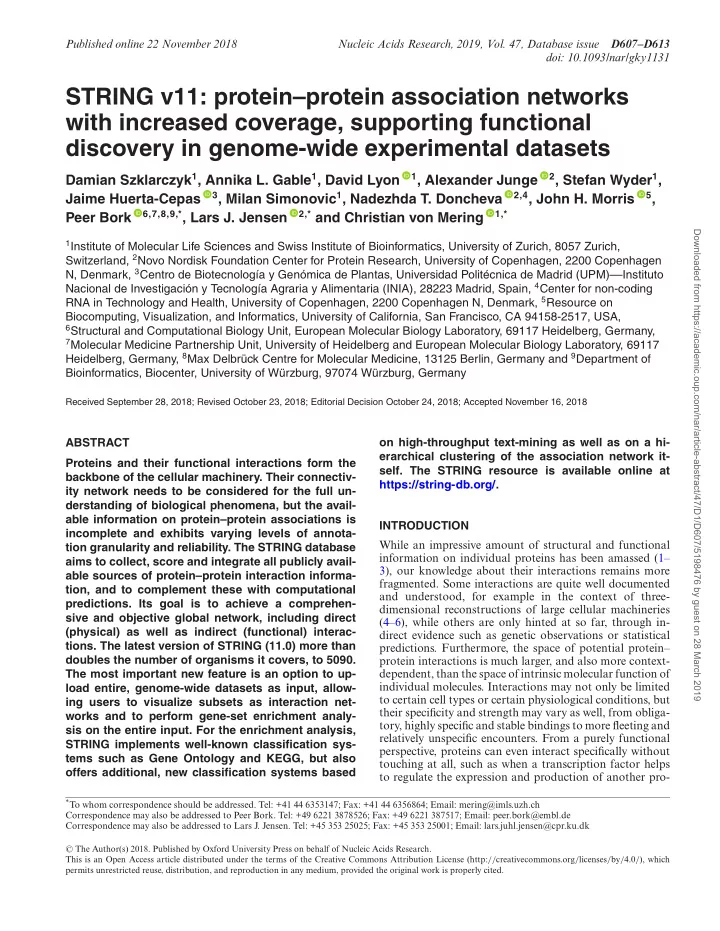

Published online 22 November 2018 Nucleic Acids Research, 2019, Vol. 47, Database issue D607–D613 doi: 10.1093/nar/gky1131 STRING v11: protein–protein association networks with increased coverage, supporting functional discovery in genome-wide experimental datasets Damian Szklarczyk 1 , Annika L. Gable 1 , David Lyon 1 , Alexander Junge 2 , Stefan Wyder 1 , 3 , Milan Simonovic 1 , Nadezhda T. Doncheva 2,4 , John H. Morris 5 , Jaime Huerta-Cepas 2,* and Christian von Mering 6,7,8,9,* , Lars J. Jensen 1,* Peer Bork Downloaded from https://academic.oup.com/nar/article-abstract/47/D1/D607/5198476 by guest on 28 March 2019 1 Institute of Molecular Life Sciences and Swiss Institute of Bioinformatics, University of Zurich, 8057 Zurich, Switzerland, 2 Novo Nordisk Foundation Center for Protein Research, University of Copenhagen, 2200 Copenhagen N, Denmark, 3 Centro de Biotecnolog´ ıa y Gen´ omica de Plantas, Universidad Polit´ ecnica de Madrid (UPM)––Instituto ıa Agraria y Alimentaria (INIA), 28223 Madrid, Spain, 4 Center for non-coding Nacional de Investigaci´ on y Tecnolog´ RNA in Technology and Health, University of Copenhagen, 2200 Copenhagen N, Denmark, 5 Resource on Biocomputing, Visualization, and Informatics, University of California, San Francisco, CA 94158-2517, USA, 6 Structural and Computational Biology Unit, European Molecular Biology Laboratory, 69117 Heidelberg, Germany, 7 Molecular Medicine Partnership Unit, University of Heidelberg and European Molecular Biology Laboratory, 69117 Heidelberg, Germany, 8 Max Delbr¨ uck Centre for Molecular Medicine, 13125 Berlin, Germany and 9 Department of Bioinformatics, Biocenter, University of W¨ urzburg, 97074 W¨ urzburg, Germany Received September 28, 2018; Revised October 23, 2018; Editorial Decision October 24, 2018; Accepted November 16, 2018 ABSTRACT on high-throughput text-mining as well as on a hi- erarchical clustering of the association network it- Proteins and their functional interactions form the self. The STRING resource is available online at backbone of the cellular machinery. Their connectiv- https://string-db.org/. ity network needs to be considered for the full un- derstanding of biological phenomena, but the avail- able information on protein–protein associations is INTRODUCTION incomplete and exhibits varying levels of annota- While an impressive amount of structural and functional tion granularity and reliability. The STRING database information on individual proteins has been amassed (1– aims to collect, score and integrate all publicly avail- 3), our knowledge about their interactions remains more able sources of protein–protein interaction informa- fragmented. Some interactions are quite well documented tion, and to complement these with computational and understood, for example in the context of three- predictions. Its goal is to achieve a comprehen- dimensional reconstructions of large cellular machineries sive and objective global network, including direct (4–6), while others are only hinted at so far, through in- (physical) as well as indirect (functional) interac- direct evidence such as genetic observations or statistical tions. The latest version of STRING (11.0) more than predictions. Furthermore, the space of potential protein– doubles the number of organisms it covers, to 5090. protein interactions is much larger, and also more context- The most important new feature is an option to up- dependent, than the space of intrinsic molecular function of individual molecules. Interactions may not only be limited load entire, genome-wide datasets as input, allow- to certain cell types or certain physiological conditions, but ing users to visualize subsets as interaction net- their specifjcity and strength may vary as well, from obliga- works and to perform gene-set enrichment analy- tory, highly specifjc and stable bindings to more fmeeting and sis on the entire input. For the enrichment analysis, relatively unspecifjc encounters. From a purely functional STRING implements well-known classification sys- perspective, proteins can even interact specifjcally without tems such as Gene Ontology and KEGG, but also touching at all, such as when a transcription factor helps offers additional, new classification systems based to regulate the expression and production of another pro- * To whom correspondence should be addressed. Tel: +41 44 6353147; Fax: +41 44 6356864; Email: mering@imls.uzh.ch Correspondence may also be addressed to Peer Bork. Tel: +49 6221 3878526; Fax: +49 6221 387517; Email: peer.bork@embl.de Correspondence may also be addressed to Lars J. Jensen. Tel: +45 353 25025; Fax: +45 353 25001; Email: lars.juhl.jensen@cpr.ku.dk � The Author(s) 2018. Published by Oxford University Press on behalf of Nucleic Acids Research. C This is an Open Access article distributed under the terms of the Creative Commons Attribution License (http: // creativecommons.org / licenses / by / 4.0 / ), which permits unrestricted reuse, distribution, and reproduction in any medium, provided the original work is properly cited.
Recommend
More recommend